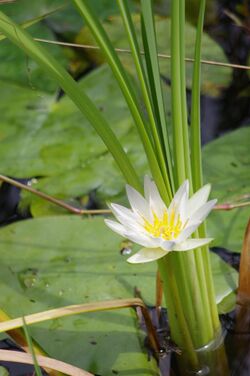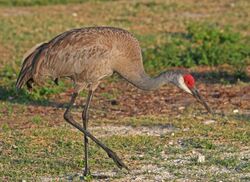Biology:Nymphaea elegans
| Nymphaea elegans | |
|---|---|

| |
| Scientific classification | |
| Kingdom: | Plantae |
| Clade: | Tracheophytes |
| Clade: | Angiosperms |
| Order: | Nymphaeales |
| Family: | Nymphaeaceae |
| Genus: | Nymphaea |
| Species: | N. elegans
|
| Binomial name | |
| Nymphaea elegans Hook., 1851[1]
| |
| Synonyms[1] | |
| |
Nymphaea elegans, also known as the tropical royalblue waterlily,[2][3] is a species of aquatic plants in the family Nymphaeaceae. It is native to the United States (Louisiana, Florida and Texas), Mexico, and the Bahamas. It has been introduced to Colombia.[1] Additionally, it has been reported to occur in Argentina.[4]
Description
This species has unbranched rhizomes, which do not produce stolons. The petiole does not have any trichomes. The upper leaf surface is green, the submerged side of the leaf is purple.[5]
Reproduction
The fragrant flowers are protogynous. During the first day of flowering they are functionally female. In following two days they are functionally male.[6]
Taxonomy
Type specimen
The type specimen was collected from a pond near the head of Leona River in 1849 by Charles Wright in Texas, USA.[6][7]
Etymology
The specific epithet elegans means fine, elegant, or handsome.[citation needed]
Ecology
Herbivory

Nymphaea elegans has been reported to be an important food plant of sandhill cranes in Texas, USA. It makes up 8.7% of their diets volume.[8]
Uses
It finds use as a medicine and for food.[1]
References
- ↑ 1.0 1.1 1.2 1.3 "Nymphaea elegans Hook." (in en). Royal Botanic Gardens, Kew. http://www.plantsoftheworldonline.org/taxon/171178-2. Retrieved 13 July 2023.
- ↑ U.S. Fish & Wildlife Service. (n.d.). Tropical Royalblue Waterlily. Retrieved July 13, 2023, from https://www.fws.gov/species/tropical-royalblue-waterlily-nymphaea-elegans
- ↑ "Nymphaea elegans". Natural Resources Conservation Service PLANTS Database. USDA. https://plants.usda.gov/core/profile?symbol=NYEL. Retrieved 11 September 2016.
- ↑ Tur, N. M. (2006). "Nymphaea elegans (Nymphaeaceae) nueva cita para la flora Argentina." Hickenia, 3, 42-167.
- ↑ Nymphaea elegans Hook. (n.d.). SEINet. Retrieved July 13, 2023, from https://swbiodiversity.org/seinet/taxa/index.php?taxon=27921&clid=83
- ↑ 6.0 6.1 Schneider, E. L. (1982). "Notes on the floral biology of Nymphaea elegans (Nymphaeaceae) in Texas." Aquatic Botany, 12, 197-200.
- ↑ Nymphaea elegans | International Plant Names Index. (n.d.). Retrieved July 13, 2023, from https://www.ipni.org/n/171178-2
- ↑ 8.0 8.1 Guthery, F. S. (1975). Food Habits of Sandhill Cranes in Southern Texas. The Journal of Wildlife Management, 39(1), 221–223. https://doi.org/10.2307/3800493
External links
Wikidata ☰ Q15482103 entry
 |

